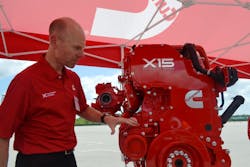EAST LIBERTY, OHIO. When going out for a spin in a truck powered by the new Cummins X15 engine, it’s good to have the program technical leader in the cab to answer questions. Even better, the engine is so quiet the conversation could’ve been conducted at a whisper. But the next-generation X Series is not something Tim Proctor, Cummins Director, Engineering, wants to keep quiet about.
Over several laps around the Transportation Research Center’s 7.2 mile high-speed loop, Proctor explained the finer points of the X15 and the Eaton SmartAdvantage Powertrain, as well the project’s goals and development challenges.
The X15 Efficiency engine is geared for 1150 rpm at cruise speed, and once the truck accelerates to 62 mph or so and the cruise control is engaged, the engine quickly—and so quietly—settles in. The instantaneous fuel consumption reading on the dash of the loaded International ProStar demonstration vehicle: 10 miles per gallon.
“When you consider driver fatigue and real-world operation, this is a really comfortable truck to drive,” Proctor said.
Read more:
But optimizing fuel efficiency around downspeeding has drawbacks, Proctor noted, pointing specifically to engine braking, which is most effective at higher revs.
“We’ve tried really hard to get the braking performance for that every day ‘off-ramp experience’—where you just want the retardation to control the braking—to be just as good at the lower engine speed, so that the driver doesn’t feel as though the truck is coasting away from him when he comes off the freeway,” he said, before going into detail about the mechanics behind cam profile design changes for the engine braking system.
For the new performance version of X15, on the other hand, the engine braking is substantially enhanced. On another of the day’s demonstrations, a truck powered by the X15 quickly geared down and decelerated, coming to an engine-only stop several truck lengths sooner than an equally loaded rig with an ISX15.
Proctor went on to explain that the X15 Series is really an evolution of the ISX15, and that the development team focused on numerous “areas of opportunity” to make small improvements—because, simply, there was no “low hanging fruit” to be picked from “what’s already, obviously, a pretty good engine.”
“It’s not like there was 3% improvement in fuel economy sitting under someone’s desk, so we concluded that evolving a product which has already got a track record was the path to greater reliability, compared to developing a new engine from scratch. There’s quite a few incremental changes, but we really only made changes where we needed to make them,” Proctor said. “To enhance the reliability, we simplified some of the systems with alternate technologies and we’ve removed some of the things that in the past have caused us problems. At the same time, we’ve made changes throughout that we can be confident in and that we know will deliver improved performance.”
For example, he explained how the team changed the design of the piston cooling nozzles to regulate the oil flow, and less oil flow meant they could redesign the oil pump as well, reducing parasitic power loss. Along with the new generation of engine lubricants, the changes provide another 0.2% improvement in fuel economy.
“All of these things knit together into a system that works,” Proctor said.
But that incremental approach—fractional improvements that, when added together, become significant—is exactly the selling point used by the truck manufacturers to support “integration,” or the advantages that can be gleaned when a powertrain—engine, transmission, axles—is developed and built by a single company. How can Cummins, as an engine builder, compete with the OEM-branded systems?
“We’ve got a really good, collaborative partnership with Eaton—you can see the way this package is working. It’s as seamless as an I-Shift or a DT-12 (Volvo’s and Daimler’s automated manual transmissions, respectively). We’re also working very closely with Dana on axles,” Proctor said. “It clearly presents some challenges for us, but one of the opportunities we have is to build partnerships with the best in the industry, as opposed to just who happens to be part of our organization—that’s a strategic advantage, to be selective.”
About the Author
Kevin Jones 1
Editor
Kevin has served as editor-in-chief of Trailer/Body Builders magazine since 2017—just the third editor in the magazine’s 60 years. He is also editorial director for Endeavor Business Media’s Commercial Vehicle group, which includes FleetOwner, Bulk Transporter, Refrigerated Transporter, American Trucker, and Fleet Maintenance magazines and websites.

